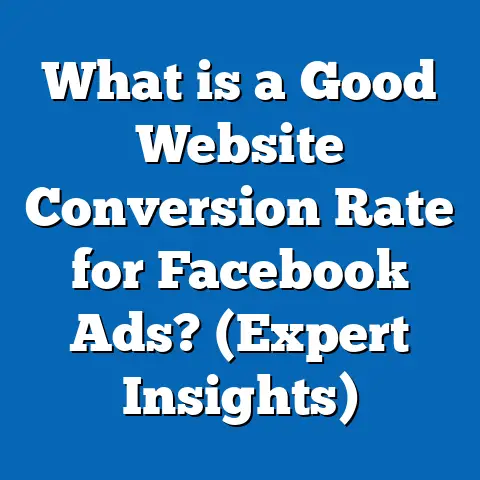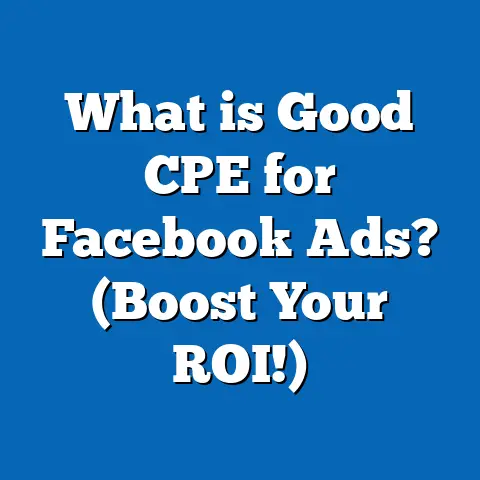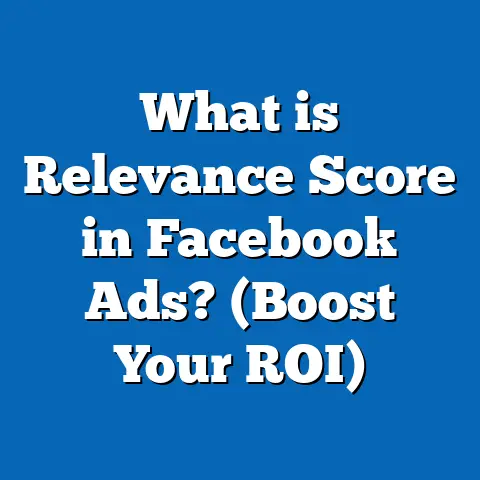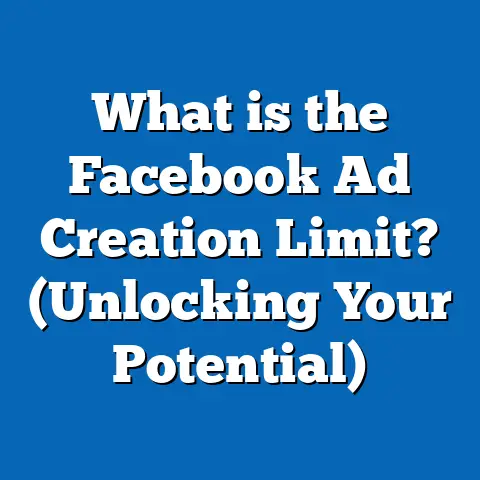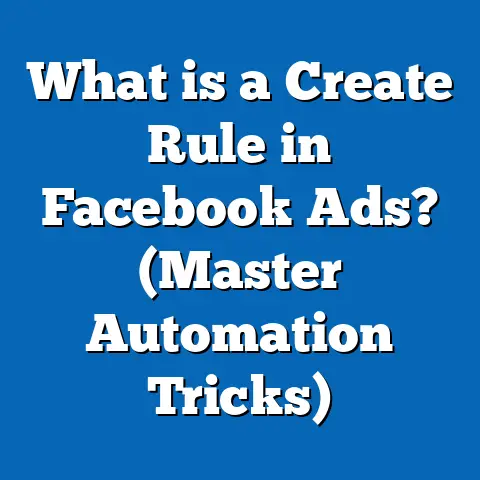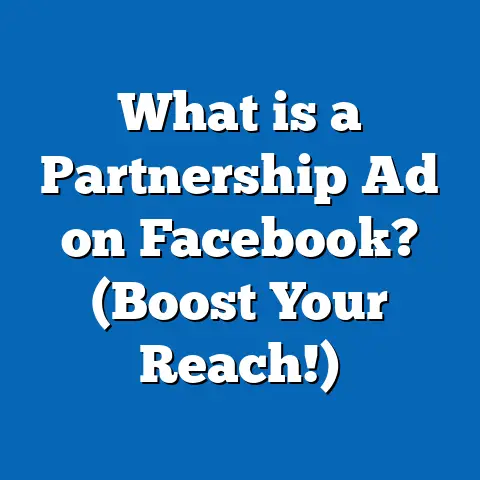What is KPI in Facebook Ads? (Unlocking Your Ad Success)
What is KPI in Facebook Ads? (Unlocking Your Ad Success)
Introduction: The Challenge of Measuring Facebook Ads Success
Digital advertising has transformed the way businesses connect with their audiences, but with great opportunity comes great complexity. Facebook, boasting over 3 billion monthly active users globally in 2024, is one of the most powerful platforms to reach potential customers. Yet, many marketers and business owners grapple with a fundamental question: “How do I know if my Facebook ads are truly working?”
The flood of metrics available — impressions, clicks, likes, shares, conversions — can be overwhelming. Without a clear framework, it’s easy to get lost in numbers that don’t reflect actual business growth. Wasting ad spend on ineffective campaigns is an expensive risk.
Understanding KPIs in Facebook Advertising
What is a KPI?
A Key Performance Indicator (KPI) is a quantifiable measure used to evaluate the success of a campaign or activity against defined objectives. Simply put, KPIs tell you if you are moving closer to your marketing goals or falling behind.
In Facebook advertising, KPIs are the metrics that matter most for understanding how well your ads perform — whether that’s driving traffic, generating leads, increasing sales, or building brand awareness.
Why Are KPIs Important for Facebook Ads?
Facebook offers an abundance of data points. While it’s tempting to track every metric, focusing on the wrong ones can mislead you into thinking your campaigns are successful when they are not.
- A 2023 survey by HubSpot revealed that 49% of marketers find it challenging to pick the right KPIs for social media.
- According to LinkedIn’s State of Marketing Report 2024, marketers who set clear KPIs achieve 23% higher ROI on average.
KPIs transform raw data into actionable insights. They help you:
- Measure progress toward specific goals
- Optimize campaigns based on evidence
- Allocate budget efficiently
- Communicate performance to stakeholders
- Avoid common pitfalls like chasing vanity metrics
Core KPIs in Facebook Ads: A Detailed Breakdown
Understanding the primary KPIs in Facebook ads is crucial. These metrics are essential for evaluating campaign health and optimizing performance.
1. Reach and Impressions
Reach refers to the total number of unique users who have seen your ad at least once. Impressions count how many times your ad was displayed in total, including multiple views by the same user.
- Reach helps gauge the size of your audience exposure.
- Impressions indicate overall ad visibility but can be inflated by repeated views.
Why Reach and Impressions Matter
For brand awareness campaigns, reach is often the most critical KPI because it shows how many people your message has touched. A high number of impressions with low reach may signal overexposure to a small audience segment.
Data Insight
- Facebook’s average CPM (cost per 1,000 impressions) ranges between $5-$15 depending on industry and targeting.
- Brands aiming for awareness often target reach metrics above 500,000 in initial campaign phases.
2. Click-Through Rate (CTR)
CTR measures the percentage of people who clicked your ad after seeing it: CTR=(ClicksImpressions)×100\text{CTR} = \left(\frac{\text{Clicks}}{\text{Impressions}}\right) \times 100
CTR indicates how compelling your creative and message are in driving users to take action.
Average CTR Benchmarks
- Overall Facebook ads CTR averages about 0.90%.
- High-performing sectors like retail and e-commerce often see CTRs between 1.5% – 2%.
- Lower CTRs can indicate misaligned targeting or weak ad creatives.
3. Conversion Rate
Conversion rate measures the percentage of users who complete a desired action after clicking your ad, such as buying a product or signing up for a newsletter. Conversion Rate=(ConversionsClicks)×100\text{Conversion Rate} = \left(\frac{\text{Conversions}}{\text{Clicks}}\right) \times 100
This KPI directly ties ad engagement to business outcomes.
Industry Benchmarks
- WordStream’s 2024 data shows average Facebook ad conversion rates between 9% and 10%.
- Higher conversion rates often result from precise audience targeting and optimized landing pages.
4. Cost Per Click (CPC) and Cost Per Acquisition (CPA)
- CPC is how much you pay for each click.
- CPA calculates the average cost to acquire a customer or lead through your ads.
Lower CPC and CPA mean better ad spend efficiency.
Average Costs
- CPC varies widely but ranges from $0.50-$2.00 across industries.
- CPA can range from $10 for simple lead generation to $100+ for high-ticket products.
Monitoring these costs helps ensure your campaign stays profitable.
5. Return on Ad Spend (ROAS)
ROAS reveals how much revenue your ads generate relative to what you spend: ROAS=Revenue from AdsCost of Ads\text{ROAS} = \frac{\text{Revenue from Ads}}{\text{Cost of Ads}}
A ROAS greater than 1 means you’re earning more than you spend; below 1 signals a loss.
ROAS Benchmarks
- E-commerce businesses typically aim for ROAS of at least 4:1.
- Service industries may accept lower ROAS due to longer sales cycles.
Advanced KPIs: Going Beyond Basics
Engagement Rate
Engagement rate measures interactions such as likes, comments, shares, and reactions relative to reach or impressions: Engagement Rate=(EngagementsReach or Impressions)×100\text{Engagement Rate} = \left(\frac{\text{Engagements}}{\text{Reach or Impressions}}\right) \times 100
High engagement signals strong audience interest and can boost organic reach.
Frequency
Frequency is the average number of times each user sees your ad: Frequency=ImpressionsReach\text{Frequency} = \frac{\text{Impressions}}{\text{Reach}}
While multiple exposures can reinforce messaging, too high frequency (>3) risks ad fatigue and negative brand perception.
Video-Specific KPIs
For video ads, two key metrics are:
- Video Views: Number of times video starts.
- Video Completion Rate: Percentage watching entire video.
Completion rates above 70% indicate effective storytelling and hold audience interest well.
How to Select the Right KPIs for Your Campaign
Step 1: Clarify Your Business Objectives
KPIs must align with your overall goals:
| Business Goal | Recommended KPIs |
|---|---|
| Brand Awareness | Reach, Impressions, Engagement Rate |
| Lead Generation | CTR, Conversion Rate, CPA |
| Online Sales | ROAS, CPA, Conversion Rate |
| Customer Engagement | Engagement Rate, Frequency |
Step 2: Consider Campaign Type
Facebook offers varied campaign objectives such as Awareness, Consideration, and Conversion. Each requires different KPIs:
| Campaign Objective | Primary KPIs |
|---|---|
| Awareness | Reach, Impressions, Engagement |
| Consideration | CTR, Video Views, Landing Page Views |
| Conversion | Conversion Rate, CPA, ROAS |
Step 3: Set Realistic Targets Based on Benchmarks
Using industry averages as reference points helps set achievable goals and identify underperformance early.
Practical Application: Using KPIs to Optimize Campaigns
Case Study: E-Commerce Brand Boosts Sales by Focusing on CPA and ROAS
Background:
An online fashion retailer spent $50,000 monthly on Facebook ads but had inconsistent sales results.
Challenges:
High CPC (<del>$1.50) and CPA (</del>$90), with ROAS fluctuating between 1.5x to 2x.
Strategy:
- Defined KPIs: Target CPA < $60 and ROAS > 3x.
- Implemented A/B testing on creatives focusing on lifestyle images vs product close-ups.
- Used audience segmentation to target lookalike audiences with past purchasers.
- Adjusted bids using Facebook’s AI optimization targeting conversions.
Results After 3 Months:
- CPC reduced to $1.00.
- CPA dropped by 35% to $58.
- ROAS improved from 2x to 3.8x.
- Monthly revenue increased by $120,000 with same budget.
Comparing Facebook Ad KPIs with Other Platforms
Understanding how Facebook KPIs stack up against other channels helps integrate cross-platform strategies effectively.
| Metric | Facebook Ads | Google Ads | Instagram Ads |
|---|---|---|---|
| Reach | Unique users exposed | Impressions | Unique users exposed |
| CTR | ~0.90% average | ~3.17% average | ~0.80% average |
| Conversion Rate | ~9%-10% average | ~4%-5% average | ~1%-3% average |
| CPC | $0.50 – $2.00 | $1.00 – $2.50 | $0.30 – $1.20 |
| ROAS | Highly variable by industry | Generally high for search intent | Variable |
Insights:
- Google Ads typically yields higher CTR due to user intent in search.
- Facebook excels in detailed targeting and engagement metrics.
- Instagram’s visual nature benefits brand-building campaigns but may have lower conversion rates compared to Facebook.
Latest Trends Influencing Facebook Ad KPIs in 2024
AI-Powered Optimization
Facebook’s AI algorithms automate bidding and audience targeting with increasing sophistication, leading to improved CPA and ROAS across industries.
Privacy Regulations & Tracking Challenges
Apple’s iOS updates restrict tracking capabilities impacting pixel data accuracy. Advertisers must adapt by using aggregated event measurement and enhanced conversion APIs.
Rise of Video Content
Video ads generate up to 25% higher engagement rates than static images according to Facebook’s internal reports from early 2024 campaigns.
Shopping & Commerce Integration
Facebook Shops and integrated checkout features reduce friction for direct purchases within the platform, improving conversion rates and ROAS for e-commerce brands.
Step-by-Step Guide: How to Track & Improve Your Facebook Ads KPIs
Step 1: Setup Tracking Tools Correctly
- Install Facebook Pixel on all relevant web pages.
- Configure standard events like Purchase, Lead, Add to Cart.
- Use Facebook Conversions API for server-side tracking where possible.
Step 2: Define Clear Campaign Objectives & KPIs Before Launch
Set measurable goals aligned with business priorities (e.g., increase sales by 20% with ROAS > 3).
Step 3: Monitor Performance Via Ads Manager Regularly
Use breakdowns by demographics, placement, device type to identify where KPIs excel or lag.
Step 4: A/B Test Creatives & Audiences Continuously
Experiment with different images, copy, CTA buttons, and audience segments focusing on improving CTR and conversion rates.
Step 5: Control Frequency & Avoid Ad Fatigue
Keep frequency below 3 per user unless retargeting warm audiences.
Step 6: Adjust Budgets Based on KPI Results
Shift budget toward high-performing campaigns or audiences showing best CPA/ROAS.
Common Mistakes When Using KPIs in Facebook Ads
- Tracking Vanity Metrics Only
Focusing on likes or impressions without measuring conversions or ROI leads to wasted spend. - Ignoring Attribution Windows
Facebook’s default attribution may not reflect actual customer journeys; customize windows based on sales cycles. - Setting Unrealistic KPI Goals
Expecting industry-beating results without adequate budget or audience size causes frustration and poor decisions. - Neglecting Cross-device & Offline Conversions
Many users convert offline or via other devices; integrate CRM data where possible for full attribution. - Failing To Update KPIs With Changing Business Goals
KPIs must evolve as campaigns move from awareness to sales focus or new products launch.
Tools & Resources for KPI Tracking in Facebook Ads
- Facebook Ads Manager: Core tool providing real-time insights into all standard KPIs.
- Facebook Analytics (deprecated but replaced by Meta Business Suite insights): Offers deeper funnel analysis.
- Google Analytics: Track post-click behavior and conversions linked from Facebook traffic.
- Data Studio or Power BI: For customized reporting dashboards pulling data from multiple sources.
- Third-party Platforms: Tools like Hootsuite Ads, AdEspresso provide enhanced KPI visualization and automation features.
Summary: Unlocking Success With Facebook Ads KPIs
Mastering Facebook ads requires more than just running campaigns; it demands focused measurement through KPIs that tie activity directly to goals. Marketers who clearly define relevant KPIs like CTR, CPA, ROAS—and adjust their tactics accordingly—can transform data into growth opportunities while avoiding costly mistakes.
Final Thoughts & Next Steps for Marketers & Business Owners
To unlock your Facebook ad success:
- Define precise business goals before every campaign.
- Select KPIs that reflect those goals concretely.
- Implement robust tracking systems including Pixel and Conversions API.
- Analyze data regularly using Ads Manager’s breakdowns.
- Experiment via A/B testing focusing on improving key metrics.
- Adapt strategy based on real-time KPI insights.
- Stay informed about platform updates affecting tracking and ad delivery.
- Integrate cross-platform data for holistic performance views.
By following these steps consistently, your Facebook advertising efforts will become more targeted, measurable, and profitable — turning clicks into customers and impressions into revenue.
If you want me to expand any section further or add additional case studies or examples, just say so!

